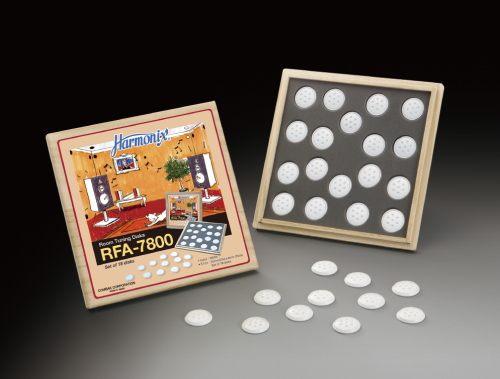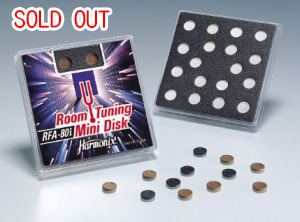 Quite a while ago I was using Combak Harmonix tuning products extensively. I had several sets of the tuning bases on just about every component and a couple of RFS-65 and RFS-66 feet under some of them. I found the products actually fixed some problems with treble stridency while enhancing smoothness, fullness and especially musicality. I’m not sure how they work: it has something to do with the miniature tuning fork inside each piece. They left an impression of being powerfully good medicine when used moderately, but possibly toxic in too large a dose. If memory serves, at one point I went too far and the sound collapsed in on itself. Time passed and I moved on. I put the tuning bases and feet away in deep storage. Quite a while ago I was using Combak Harmonix tuning products extensively. I had several sets of the tuning bases on just about every component and a couple of RFS-65 and RFS-66 feet under some of them. I found the products actually fixed some problems with treble stridency while enhancing smoothness, fullness and especially musicality. I’m not sure how they work: it has something to do with the miniature tuning fork inside each piece. They left an impression of being powerfully good medicine when used moderately, but possibly toxic in too large a dose. If memory serves, at one point I went too far and the sound collapsed in on itself. Time passed and I moved on. I put the tuning bases and feet away in deep storage.
Recently, however, Harmonix products, specifically the RFA-78i Room Tuning Discs, surfaced in several conversations I had with industry insiders. I was intrigued.
Application
I positioned at least one RFA-78i Room Tuning Disc in all ceiling corners of my listening room, replacing either Golden Sound Acoustic Discs or Echo Buster Corner Tunes. All large glass surfaces were treated, i.e. windows, breakfronts and framed pictures. The metal face of the heating convector unit got a disc, too. The brief instructions included in the unassuming wooden box recommended removing all other acoustic treatments, and I sorta tried this with a few Echo Buster diffusion panels, but immediately put them back. In my 12’ wide by 31’ long by 8’ high room, one box of 16 discs gave me a very good taste of the effect.
Sonic Effects
I didn’t hear a night and day difference when I put in the RFA-78i. What I did notice was a multitude of subtle improvements that congregated around two areas—credibility, or to what degree the facsimile you’re listening to is convincing, and the quality of the soundstage.
Vivaldi’s La Stravaganza, performed by Rachel Podger and Arte Dei Suonatori [Channel Classics GCS 19598], is a wonderful two-disc set brought to my attention in Stereophile Magazine’s Recording of the Month column. (Generally those guys hit it right, but sometimes they miss the mark, as in the same column’s recommendation of the Capucon brothers’ recording of the Franck and Rachmaninov sonatas [EMI Classics 5 575052]. That one I found wanting in both performance and sonics). The RFA-78is added the last coat of varnish to the finish on Ms. Podger’s violin, imparting a warmer, richer, more lustrous sound, as if she was now playing on one of those priceless Strads.
How the discs work their magic is a mystery to me, and the company’s literature doesn’t give an explanation. I’ll go out on a limb here and proffer my own theory based on what I’m hearing. I think the discs work by eliminating stray frequency-related noises by means of the miniature tuning fork contained inside. Sound energy floating around the room is “processed,” or tuned, to the frequency of the tuning fork. Less spurious treble noise means there’s less edge, less brightness and the noise floor drops. Pace and rhythm, along with color and nuance, are enhanced. The tuned sound that results is thus more pleasing. Note that these effects are achieved without dampening the buoyancy of the music: almost as much energy is present in a treated room as before treatment.
“Concert Hall Realism”
If you like imaging, you’ll love the psycho-acoustic tricks the RFA-78is play. It’s almost eerie how the stage floats outside the parameters of the room. The musicians seem to parade in front of you, very detached from the physical room, in a space that only exists in your perception. The RFA-78is clarify the encoded cues delineating the recording venue and make them more obvious. To the trained ear, it became easier to suspend disbelief and imagine something like a concert hall within my room.
I was used to my soundstage depth having a shape like a trapezoid, narrowing as it went deeper. With the RFA-78is in place, stage width at the front is about the same, but it maintains more of a square shape as it recedes. Left/right balance is better (or maybe just better defined?). Overall layering in space improved, and individual instruments exhibit a little more depth and roundness in their own 3-D effect, and less frequency-related drifting around the stage. I especially like these improvements in dimensional cues and left/right balance.
It will take some experimenting to find the optimum placement in your room. I started by following the instruction sheet, but then intuition suggested I try re-positioning some discs onto highly resonating surfaces. Fortunately, the RFA-78i, which look like white, textured quarters, attach easily with double stick tape and can be removed with a little care. Using the knuckle rap-test to find these resonating villains, I moved ceiling corner discs to mid-wall locations, and added more to the glass breakfront (There are a total of three there now; this freestanding furniture has glass on four sides, and you can hear it ring when the music gets loud). Then I tried four in a row along the length of the ceiling, as the distributor recommended. This was not intuitive: my ceiling is a thick slab of concrete. ‘Twas good. Even more sound-stage clarity ensued. The quality of spatial layering I’m getting is really exceptional.
Be careful though: As you add discs the effect accrues, until you cross a threshold where the sound collapses, very similar to my experience with the tuning bases and feet. If a little is good, a lot is not necessarily better.
Conclusion
The RFA-78i Room Tuning Discs tune the sound energy floating around your room. Unlike most other products of this sort, however, they don’t try to absorb or eliminate that energy. What they seem to do is tune it to a pleasing frequency and then release it, and in the process reduce noises and odd-order harmonics. They create a beautiful space ideal for music. Many concert halls only wish they sounded like this!
There is one small downside. When guys come over now a lot of the discussion is about where the musicians are located spatially, what kind of microphones were used and how they were deployed, was compression/limiting used, etc. All this information distracts them and there’s less talk about the music. Hey, some guys really get off on this!
Yes, RFA-78i Room Tuning Discs are expensive, but well worth it. Once your room is tuned, I don’t think you’ll ever consider removing them.
|







